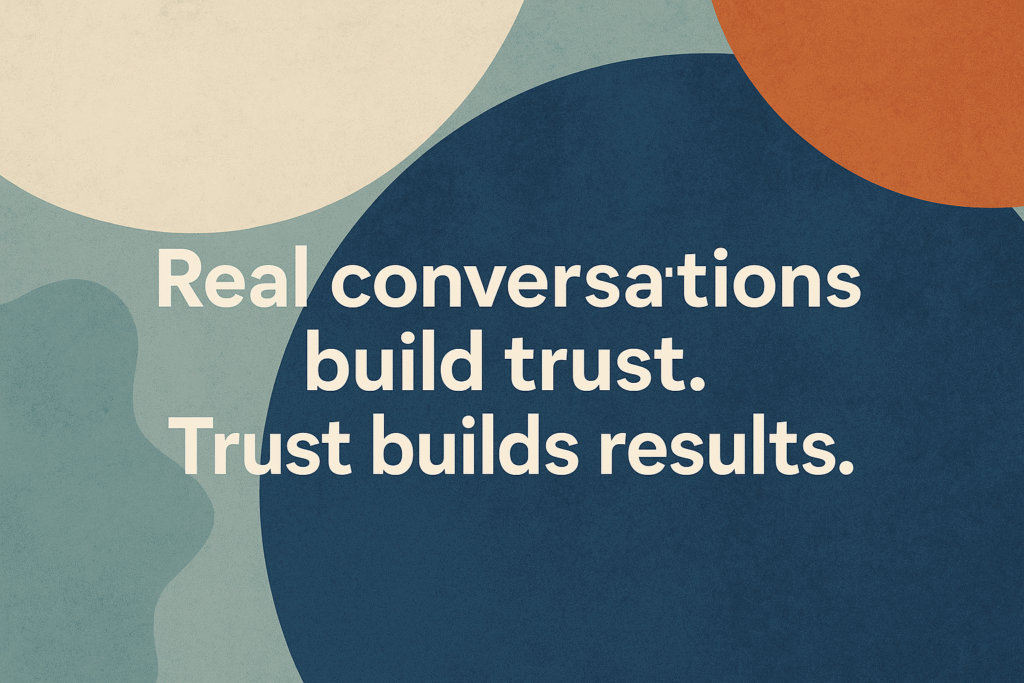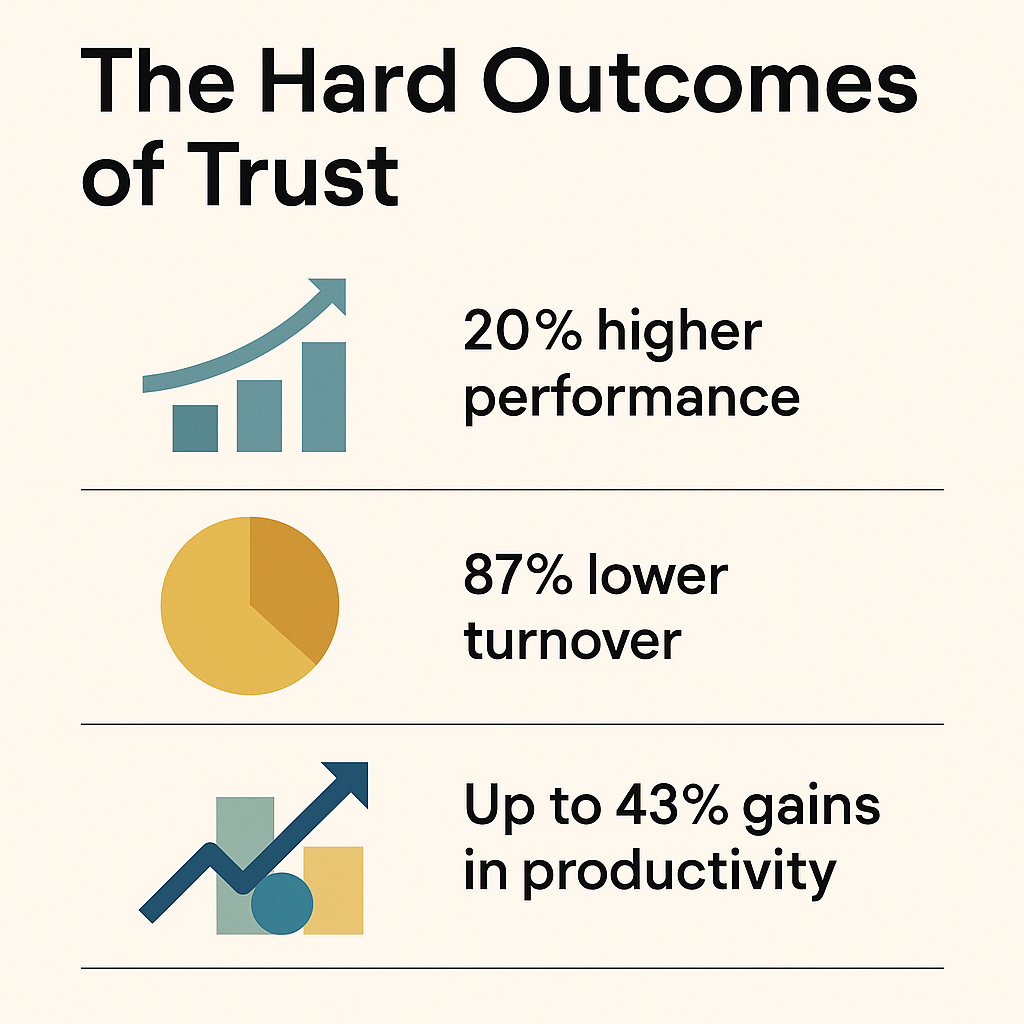by JD Woods,
Principal Consultant, The Weiwood Group
Why honest conversations between leaders and teams aren’t just good leadership, they’re a measurable business advantage.
Introduction
I’ve been fortunate to reach a point in my career where the owners and CEOs I work with invite me into conversations that stretch beyond my immediate role or assignment. Over the years, I’ve noticed a recurring challenge that sneaks into leadership discussions: how to strike the right balance between optimism and reality.
Leaders are often natural visionaries. They paint pictures of a brighter future, outline ambitious goals, and rally people around possibilities. But here’s the catch: when leaders talk about the future without acknowledging today’s obstacles, they unintentionally chip away at the very thing they need most – trust.
Employees can spot when there’s a disconnect between the message and the reality they experience every day. When that gap widens, credibility suffers. And it’s not just a feeling. Research confirms that executives consistently overestimate the trust their employees place in them. A recent PwC survey found that while 86% of leaders believe their people trust them, only 67% of employees agree. That 18-point gap is more than a perception issue—it’s a performance issue.
Because here’s the truth: trust is not a soft skill. It’s a business outcome. It directly influences engagement, retention, and productivity—and the difference shows up in the numbers.
The Trust Gap
In boardrooms and leadership off-sites, I often hear leaders describe their culture as “open,” “transparent,” or “trust-based.” And in many cases, their intentions are genuine. But intentions don’t always match reality on the ground.
That’s where the trust gap shows up.

The PwC study makes it plain: while 86% of executives believe their employees trust them, only 67% of employees feel the same. That’s not a minor discrepancy—it’s an 18-point credibility gap. Think about what that really means: nearly one in five employees is quietly unconvinced by the messages they hear from leadership.
When trust wavers, so does engagement. Employees may nod along in meetings, but their energy, creativity, and loyalty don’t follow. Instead, they disengage, and the costs are real. Gallup has long shown that disengaged employees drive billions in lost productivity each year. On the flip side, employees in high-trust environments consistently deliver stronger results: 20% higher performance, 87% lower turnover risk, and productivity gains up to 43%.
The uncomfortable truth is that leaders often measure trust by how they intend to communicate—through vision statements, town halls, or surveys—while employees measure trust by how leaders actually show up in conversations. And that’s where the disconnect begins.
What the Research Tells Us
If trust is the problem, what’s the solution? Fortunately, there’s no shortage of research showing exactly what builds credibility between leaders and their teams, and it doesn’t require expensive programs or elaborate communication campaigns. It comes down to how leaders talk, listen, and act.
Authenticity drives engagement.
Studies show that authentic leadership, traits like transparency, balanced judgment, and self-awareness directly improves employee trust and engagement. When leaders acknowledge both the wins and the setbacks, they earn credibility. Employees don’t expect perfection; they expect honesty. A manager who can say, “Here’s what’s working, here’s what isn’t, and here’s how we’ll tackle it,” immediately creates a stronger bond than one who relies on polished talking points.
Empathy accelerates trust.
The global pandemic made this clearer than ever. Research on leadership during COVID-19 found that leaders who used empathetic language had the greatest impact on trust, more than even providing clear direction or inspiring meaning. In other words, clarity is important, but showing you see and hear your people matters even more. Employees want leaders who not only outline the path forward, but also acknowledge the human experience of walking it.
Managers are the gatekeepers of trust.
It’s also worth noting that employees don’t always judge “the company” by its CEO or its mission statement. For most people, the company is their manager. In fact, 84% of employees say they rely on their direct manager for critical communication. This means trust isn’t built in corporate memos—it’s built (or broken) in one-on-ones, team huddles, and the everyday conversations that shape how people feel about their work.
Surveys aren’t enough.
Employee engagement surveys are everywhere, but they rarely build trust on their own. Why? Because employees don’t just want to be asked for feedback—they want to see and hear what leaders do with it. A “thank you for your input” email, followed by business as usual, actually erodes credibility. By contrast, a leader who sits down with their team to discuss survey results candidly—and then follows up with clear actions—turns data into trust.
Outcomes That Can’t Be Ignored
It’s tempting to think of trust as an abstract, “soft” element of leadership—something nice to have, but not a measurable driver of results. The data tells a very different story.
Organizations that foster high-trust environments see 20% higher performance from their employees. That means projects finish faster, goals are met more consistently, and teams are more resilient in the face of challenges.
Trust also reduces risk in one of the most expensive areas of business: turnover. Employees who trust their leaders are 87% less likely to leave, saving companies the immense costs of recruiting, training, and the hidden drain of lost institutional knowledge.

And when trust is strong, the payoff in productivity is dramatic—up to 43% gains. Imagine what that kind of lift means across a full organization: more innovation, smoother execution, and a workforce aligned not just with the company’s goals, but with its leaders’ credibility.
These aren’t “soft” results. They’re hard business outcomes. Trust directly translates into performance, retention, and growth. Which is why the credibility gap between leaders and employees isn’t just a cultural challenge—it’s a strategic one.
How to Lead With Real Conversations
The good news is that closing the trust gap doesn’t require complicated systems or expensive initiatives. It requires intention and the willingness to have honest, human conversations. Here are a few practices that consistently make the difference:
Pair vision with reality.
A compelling future vision is essential, but it rings hollow if leaders don’t also acknowledge today’s constraints. Employees respect candor. Saying “Here’s where we’re headed, and here’s what’s holding us back right now” builds credibility. People would rather walk a tough road with a leader they trust than follow an unrealistic map.
Hold regular state-of-the-business conversations.
Trust grows in frequency. Whether through one-on-one check-ins, team huddles, or open Q&A forums, leaders who talk openly and often create space for trust to take root. Silence, on the other hand, breeds doubt.
Listen first, act visibly.
The most powerful part of a real conversation isn’t the talking, it’s the listening. Ask open questions, invite feedback, and show curiosity. Then, turn what you’ve heard into visible action. Even small changes made in response to employee input signal that the dialogue is real, not performative.
Lead with empathy and transparency.
When leaders share their thought process, admit what they don’t know, or acknowledge the human side of business pressures, they send a powerful message: “We’re in this together.” Empathy and transparency cost nothing, but they earn dividends in loyalty and trust.
Closing Call to Action
At the end of the day, trust isn’t built in strategy decks, surveys, or town hall presentations. It’s built in the conversations leaders have every day—conversations where they balance optimism with honesty, vision with reality, and direction with empathy.
The research is clear: when trust is strong, performance rises, turnover falls, and productivity climbs. But more than that, people feel connected, engaged, and willing to give their best.
The challenge for leaders isn’t whether to build trust—it’s how quickly they’re willing to make real talk part of their leadership style. Because every conversation is either strengthening credibility or quietly eroding it.
So here’s the question worth asking: When was the last time you had a candid, human conversation with your team about both the wins and the struggles?

For leaders ready to close the gap between intention and perception, and to turn trust into measurable results, that’s where the work begins. At The Weiwood Group, we help organizations unlock that potential—by blending strategy, operations, and leadership practices that build trust where it matters most: in the conversations between managers and their people.
Real conversations build trust. Trust builds results.


